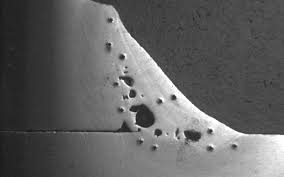What is Porosity in Welding: Best Practices for Avoiding Permeable Welds
What is Porosity in Welding: Best Practices for Avoiding Permeable Welds
Blog Article
Unwinding the Mystery of Porosity in Welding: Tips for Reducing Defects and Making Best Use Of Quality
In the detailed globe of welding, porosity continues to be a relentless obstacle that can dramatically impact the top quality and integrity of welded joints. As we delve into the depths of porosity in welding, revealing the secrets to its prevention and control will certainly be critical for professionals looking for to grasp the art of high-quality weldments.
Understanding Porosity in Welding
Porosity in welding, a common concern come across by welders, refers to the existence of gas pockets or spaces in the welded material, which can endanger the honesty and quality of the weld. These gas pockets are typically caught throughout the welding process because of various variables such as improper shielding gas, polluted base materials, or incorrect welding criteria. The development of porosity can compromise the weld, making it susceptible to fracturing and corrosion, inevitably bring about structural failings.
Comprehending the root creates of porosity is vital for welders to efficiently prevent its event. By acknowledging the significance of keeping appropriate gas shielding, making certain the tidiness of base materials, and optimizing welding setups, welders can substantially decrease the chance of porosity formation. In addition, using techniques like pre-heating the base product, utilizing correct welding methods, and performing complete inspections post-welding can better help in decreasing porosity defects. Generally, an extensive understanding of porosity in welding is crucial for welders to produce premium and durable welds.

Typical Sources Of Porosity
When checking welding procedures for potential high quality concerns, recognizing the common root causes of porosity is crucial for maintaining weld honesty and stopping architectural failures. Porosity, characterized by the existence of tooth cavities or spaces in the weld metal, can considerably jeopardize the mechanical properties of a bonded joint. One usual root cause of porosity is incorrect securing gas insurance coverage. Inadequate shielding gas flow rates or inappropriate gas mixtures can result in atmospheric contamination, leading to porosity development.
Furthermore, welding at improper criteria, such as exceedingly high travel speeds or currents, can create extreme turbulence in the weld swimming pool, trapping gases and causing porosity. By resolving these usual causes via correct gas protecting, material prep work, and adherence to optimal welding criteria, welders can lessen porosity and enhance the top quality of their welds.
Methods for Porosity Prevention
Carrying out efficient precautionary measures is critical in decreasing the incident of porosity in welding processes. One strategy for porosity prevention is ensuring correct cleansing of the base metal prior to welding. Pollutants such as oil, grease, corrosion, and paint can cause porosity, so extensive cleaning making use of proper solvents or mechanical methods is crucial.

An additional key preventative procedure is the selection of the ideal welding consumables. blog Using high-grade filler materials and securing gases that appropriate for the base steel and welding process can dramatically decrease the threat of porosity. Furthermore, keeping proper welding specifications, such as voltage, current, travel rate, and gas flow rate, is essential for porosity prevention. Differing the recommended settings can cause improper gas insurance coverage and inadequate combination, bring about porosity.
Furthermore, utilizing appropriate welding methods, such as keeping a regular traveling rate, electrode angle, and arc size, can help prevent porosity (What is Porosity). Sufficient training of welders to ensure they comply with finest methods and quality assurance treatments is additionally essential in reducing porosity problems in welding

Best Practices for Top Quality Welds
One key technique is keeping appropriate cleanliness in the welding location. Thoroughly cleaning up the workpiece and bordering location before welding can aid reduce these concerns.
One more ideal practice this post is to meticulously select the ideal welding parameters for the certain materials being joined. This consists of setting the right voltage, existing, travel speed, and securing gas flow rate. Appropriate parameter selection makes certain optimal weld penetration, combination, and total quality. Additionally, making use of top quality welding consumables, such as electrodes and filler metals, can dramatically impact the final weld high quality. Spending in costs consumables can result in stronger, more resilient welds with fewer flaws. By adhering to these ideal techniques, welders can consistently produce top quality welds that satisfy market requirements and surpass client expectations.
Value of Porosity Control
Porosity control plays a critical function in guaranteeing the integrity and top quality of welding joints. Porosity, identified by the existence of cavities or gaps within the weld metal, can considerably endanger the mechanical properties and architectural integrity of the weld. Too much porosity deteriorates the weld, making it much more at risk to splitting, corrosion, and total failure under functional loads.
Effective porosity control is crucial for maintaining the preferred mechanical properties, such as stamina, ductility, and sturdiness, of the welded joint. What is Porosity. By lessening porosity, welders can boost the overall quality and dependability of the weld, making certain that it meets the performance demands of the desired application
Furthermore, porosity control is important for accomplishing the wanted visual look of the weld. Excessive porosity not only compromises the weld however additionally takes away from its aesthetic appeal, which can be vital in sectors where aesthetics are necessary. Appropriate porosity control techniques, such as utilizing the proper securing gas, managing the welding criteria, and ensuring proper tidiness of the base products, are important for producing high-quality welds with marginal defects.

Final Thought
To conclude, porosity in welding is an usual problem that can compromise here are the findings the high quality of the weld. By comprehending the causes of porosity and carrying out proper prevention techniques, welders can decrease flaws and achieve better welds. It is necessary to regulate porosity in welding to ensure the integrity and strength of the end product. Implementing finest methods for porosity control is critical for accomplishing ideal welding outcomes.
Report this page